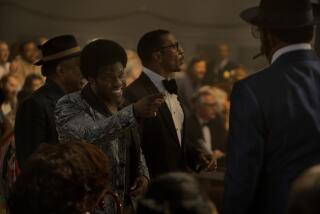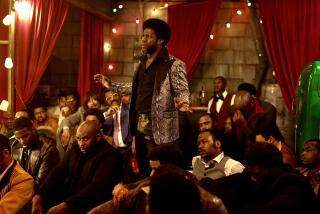DARK TRADE: Lost in Boxing.<i> By Donald McRae</i> .<i> Mainstream: 380 pp., $19.95</i> : MORE THAN A CHAMPION: The Style of Muhammad Ali. <i> By Jan Philipp Reemtsma</i> .<i> Translated from the German by John E. Woods</i> .<i> Alfred A. Knopf: 168 pp., $21</i>
In a fully civilized society, professional boxing would not exist. That it so profitably flourishes in the United States, where purses for highly publicized if unexceptional fights routinely involve millions of dollars, is a testament to both the flawed nature of our society and our dark fascination with this cruelest of sports. These two very different books, both in the way of memoirs by men long involved with boxing, may help to illuminate some of this fascination with what Mike Tyson has eloquently called “the hurt business.”
Of the two, Donald McRae’s lengthy, ambitious “Dark Trade: Lost in Boxing” is the more engaging and sympathetically rendered. While Jan Philipp Reemtsma is cerebral and analytical in his “More Than a Champion,” McRae is emotionally direct; while the German Reemtsma’s boxing experience seems, oddly, to be secondhand by way of television, tapes and books, the South African-born McRae, in thrall to a 30-year boxing addiction, has seen countless fights both minor and major in England and the United States, and is on friendly, even intimate, terms with a number of boxers and their associates and families. “Dark Trade” bears comparison with Thomas Hauser’s classic “The Black Lights: Inside the World of Professional Boxing” (1986), but though Hauser concentrated on the ascendant career of the promising but limited super-lightweight Billy Costello, “Dark Trade” is more picaresque in form, taking the reader ringside to vividly rendered, in several cases graphically brutal, matches involving such well-known boxers as heavyweights Tyson, Frank Bruno and Evander Holyfield; middleweights Chris Eubank, Michael Watson (whose September 1991 match with Eubank ended with his collapse and brain damage), Roy Jones and James Toney (McRae’s closest boxer-friend); lightweights Oscar De La Hoya and Julio Cesar Chavez; and featherweights “Prince” Naseem Hamed and Steve Robinson. McRae brings to the highly charged, obsessive world of professional boxing a novelist’s eye and ear for revealing detail and convincingly recalled dialogue. This is an impassioned book, and something of a confession, for McRae fell under the spell of boxing in the 1960s, in the era of Cassius Clay/Muhammad Ali--a heroic figure whose worldwide celebrity helped forge a spiritual bond between the South African middle-class white boy and his black contemporaries, who at that time were politically disenfranchised by apartheid. Partly out of disgust with South African politics, McRae emigrated to England as a young man, where he became involved in boxing as an ardent observer and commentator. If “lost” in boxing, McRae also found his metier, or, as a typically fatalist boxer might say, his destiny.
Instead of the mordantly revealing title “Dark Trade,” McRae’s original title for this book was the more ebullient “Showtime”:
“In the beginning I wanted to celebrate boxing. I planned to write about the bravest and the most skillful fighters, describing their big heart and sparkle. . . . I thought there was something beautiful and poetic in the solitary way they both prepared for a fight and then, afterwards, held each other in relief. . . . Yet these stories now touch as much on death. It was not meant to end up this way.” McRae questions the morality of his involvement in a sport that some of its own practitioners would not call a “sport” but a trade that deals in brutality and hurt. And though a famous boxer like Tyson, though conspicuously past his prime, may earn as much as $140 million for six undistinguished fights within 16 months of his being released from an Indiana prison as a convicted rapist--a testament less to the connivance of boxing promoters than to the inexhaustible gullibility of the public--most boxers, including such great champions as Joe Louis and even Ali, are victims, exploited by managers, promoters and their own dreams of grandeur and immortality. “Deep down, they know that they’re fated to lose. They are not ‘losers’ in terms of their character but, rather, in the more overpowering sense of destiny being stacked against them. . . . In the end, no matter how hard they train or abstain, boxing gets them.”
Defensive with outsiders, boxing admirers are often ambivalent about their admiration and may not entirely disagree with those who believe, on ethical and medical grounds, that boxing should be abolished by law. (Having witnessed “death bouts,” McRae thoughtfully discusses this perennial issue.) Yet for all its brooding, “Dark Trade” is an immensely readable book that anyone with an interest in boxing will want to own. And it manages to conclude on an upbeat, if qualified, note: After the debacle of Tyson, the first heavyweight in 50 years to be disqualified for unprofessional behavior in the ring (for twice biting the ear of opponent Holyfield in their June 1997 championship match), McRae focuses upon the admirable, “decent” Holyfield as a model for contemporary boxing, as Ali was a model for his era. Boxing is finally about not the “lunacy” of a Tyson but the discipline and sportsmanship of a Holyfield. So long as boxers like Holyfield continue to fight, McRae will watch: “I can’t help it. I, too, am yet to be released.”
Is Louis, who held the heavyweight title from 1937 to 1950, or Clay/Ali, who won the title three times during his celebrated career from 1964 to 1980, the greatest heavyweight in history? A futile issue to debate, yet irresistible: For though Louis in his prime may well have knocked out Ali in his prime, Ali might well have outboxed (or outfoxed) the harder-hitting Louis as he did the extraordinary puncher George Foreman. So boxing experts love to argue. Yet it’s clear that Ali’s magic transcended Louis’, as it transcended boxing itself, through his courageous refusal to be inducted into the U.S. Army to fight in Vietnam in 1967, which resulted in the loss of his boxing license and his title for three years. Ali’s celebrity was partly a phenomenon of contemporary mass media that exported his handsome, charismatic image worldwide; he was, perhaps still is, along with Elvis Presley, the most universally identified “American” personality. Donald McRae’s boxing memoir begins with Cassius Clay in the 1960s and ends with the recent film “When We Were Kings,” a documentary on the 1974 Ali-Foreman fight in Zaire, and the abrupt outburst:
“The longer boxing existed without Ali, the crazier it became. The further Ali receded into memory, the more depraved boxing appeared. No fighter could match his genius either in or out of the ring. . . . But it is more the way in which Ali lived his life beyond the ropes which overwhelms all the fighters who have followed him. Ali transformed himself. He became a man far greater than a stark figure of violence or a cartoon character of hype.”
In the slender, eccentric “More Than a Champion: The Style of Muhammad Ali,” Reemtsma, a philologist by training and director of both the Hamburg Institute for Social Research and the Arno Schmidt Foundation, posits a provocative theory that Ali may be “the first postmodernist strategist”--presumably of boxing--because he cultivated so playfully ironic a persona with the press and with his opponents. Amid what he calls “anthropological speculation” that non-postmodernist readers may find baffling, Reemtsma argues that Ali is the prototype of a future human being “that we basically do not know at all, yet which for now is intimated only in its first traits, but to which the future probably belongs.” Ali is a “cross between the Proteus-like dissociated individual and its antitype” who can be understood only if “one understands the connection between the dissociated individual and the megalomaniac, or put another way, between variability and dominance.”
Impressed by Ali’s renowned versatility in the ring, Reemtsma comes to the odd conclusion that such brilliance is sui generic; had he watched tapes of Ali’s distinguished predecessors in lighter weights, where rapid footwork is the norm, notably Sugar Ray Robinson, from whom Ali learned a good deal, he would have seen that “dissociation” and “Protean” are just another way of saying that the shrewd boxer adapts to each new opponent and new situation with the intention not of displaying a dramatic ring style but more practicably of winning the fight. And though Reemtsma remarks in passing that Ali was a “second Jack Johnson,” he fails to connect Ali’s boxing persona with the legendary Johnson, the first black heavyweight titleholder (1898-1915), whose calculatedly “outrageous” behavior--his public arrogance and his relationships with white women--as well as his remarkable boxing skills made him one of the most controversial athletes in American sports history.
Much of “More Than a Champion” is taken up with a blow-by-blow account of Ali-Frazier III (Manila, 1975), the fight that is generally considered Ali’s (and Frazier’s) greatest. Unfortunately, Reemtsma’s approach to this much-analyzed fight isn’t very original or interesting. Yet more belabored and tedious is his exhaustively detailed summary of Sylvester Stallone’s “Rocky” films--which are as much about professional boxing as “E.T.” is about extraterrestrial life in the universe. Though Reemtsma’s admiration for Ali appears to be genuine, if a bit hyped, he lacks the writerly ability of a McRae to communicate the passion (and ambivalence) of such admiration. No doubt the book is being published in the United States because of its “intellectual” presumptions, but in fact it’s a dubious, sketchy and at times unintentionally funny logomachy padded with quotations from such estimable German sources as Christoph Martin Wieland’s “Samtliche Werke” and Thomas Mann’s “Felix Krull” and allusions to Homer, Goethe, Freud, Kafka and the Holocaust analyst Leo Lowenthal; it’s studded with questionable declarations (“We do not learn anything from victories”), and even these provocative declarations are awkwardly expressed:
“We do not grow from defeat. We are destroyed by defeat, and if not destroyed, then deformed; or we ‘change’--it is not easy, and perhaps it is not necessary, to differentiate all this very precisely. Defeat does not make us stronger, either. Weakness (whatever its basis) is the cause and effect of defeat.” (Critics of American “postmodernist” intellectuals might take note that such malaise is international.)
Leaving aside for the moment the syntactical confusion of such a statement, how can it possibly relate to boxing? History is rich with wonder tales of boxers who learned from defeat, among them Louis (who lost his first title fight with Max Schmeling in 1936, then won the rematch in 1938), Floyd Patterson (who lost ingloriously to the Swedish Ingemar Johansson in 1959 but won their next two fights to regain his title in 1960) and Ali himself in his rematches with Frazier and Leon Spinks, who’d beaten him in 1978. If anything dogmatic can be said about boxing, it’s that the great boxer is precisely the man who learns from being defeated.
“More Than a Champion” may be more persuasive in the original German. As it is, something crucial seems to be lost in the translation. By exaggerating Ali in an invented role as “Proteus homo novus and ruler of worlds,” Reemtsma devalues Ali’s humanity and his victimhood by boxing. With its self-conscious postmodernist theorizing and attenuated sense of boxing history, this document brings to mind the old boxing adage, “Everybody’s got a plan until they’re hit.”
More to Read
Go beyond the scoreboard
Get the latest on L.A.'s teams in the daily Sports Report newsletter.
You may occasionally receive promotional content from the Los Angeles Times.









